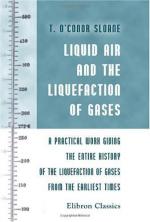|
This section contains 1,205 words (approx. 5 pages at 300 words per page) |

|
Since the 1600s, chemists have known that temperature can determine whether a substance exists as a gas, liquid, or solid. Flemish chemist Jan van Helmont (1579-1644), who coined the term gas to describe carbon dioxide, used the term vapors to describe substances that became gaseous only when heated, such as water. During the late 1700s, scientists learned that when a gas is cooled, its volume is reduced by a predictable amount. Cooling slows down the motion of the gas molecules, so they take up less space. Similarly, pressurizing a gas, or forcibly squeezing its molecules closer together, reduces its volume. Eventually, through cooling and compression, the volume of a gas can be reduced by so much that its molecules collapse upon each other and come into contact, changing into a liquid. Compression and cooling soon became the twin tools of scientists attempting to liquefy...
|
This section contains 1,205 words (approx. 5 pages at 300 words per page) |

|


